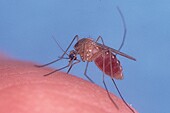
MONDAY, Aug. 13 (HealthDay News) — The Dallas-Fort Worth metropolitan area — the epicenter of the nation’s worst outbreak of West Nile virus this year — could see aerial spraying of insecticides as early as Thursday night to help control the potentially deadly mosquito-borne disease.
Dallas County has counted 120 cases so far while Texas overall has seen 351 cases, putting it “on track to be the worst year ever for West Nile virus,” said Christine Mann, a spokeswoman for the Texas Department of State Health Services.
With nine deaths reported so far, Dallas County officials on Friday declared an emergency. The north Texas region has reported 12 deaths.
On Monday, the county gave the go-ahead for aerial spraying of insecticide for the first time in 50 years, although local communities will have to approve the move before spraying begins, according to published reports.
Louisiana and Mississippi have also been hit hard by West Nile virus. Louisiana health officials have reported a total of 68 cases and six deaths, while authorities in Mississippi have reported 59 cases and one death.
The United States is experiencing the biggest spike in West Nile virus since 2004, health officials reported.
Dr. Marc Fischer, a medical epidemiologist with the U.S. Centers for Disease Control and Prevention’s Arboviral Diseases Branch in Fort Collins, Colo., said a “seasonal outbreak occurs every year but so far this year the activity seems to be greater and a little earlier than in recent years.”
It’s difficult to pinpoint why virus activity is higher this year and why it is higher in certain regions.
“That’s impacted by a number of factors, environmental factors like weather, heat, precipitation, the birds that are around to amplify the virus and maintain it, the mosquitoes that spread the virus, and human behavior,” he said.
Eighty percent of people who are infected with West Nile virus develop no or few symptoms, while 20 percent develop mild symptoms such as headache, joint pain, fever, skin rash and swollen lymph glands, Fischer said.
Less than 1 percent will develop neurological illnesses such as encephalitis or meningitis. People at greater risk for serious illness are those who are older than 50 and who have certain underlying medical conditions such as cancer, diabetes or high blood pressure, the CDC said.
Severe symptoms can include high fever, headache, neck stiffness, disorientation, coma, tremors, convulsions, muscle weakness, loss of vision, numbness and paralysis. These symptoms may last several weeks, according to the CDC.
In more extreme cases, the virus can lead to serious neurologic illness, such as encephalitis or meningitis (inflammation of the brain or surrounding tissues), or death. People older than 50 and those with certain medical conditions, such as cancer, diabetes, hypertension, kidney disease and organ transplants, are at greater risk for serious illness, according to the CDC.
Fischer said that “children can certainly be infected with West Nile virus but are less likely to get serious neurological illness.”
There are no specific treatments for West Nile virus, which was first identified in the United States in 1999.
The greatest risk for infection with West Nile virus typically occurs from June through September, with cases peaking in mid-August. But changes in the weather, the number of infected mosquitoes and human behavior can all influence when and where outbreaks occur, the CDC said.
Although most people with mild cases of West Nile virus will recover on their own, the CDC recommends that anyone who develops symptoms should see their doctor right away.
The best way to protect yourself from West Nile virus is to avoid getting bitten by mosquitoes, which can pick up the disease from infected birds. The CDC recommends the following steps to protect yourself:
- Use insect repellents when outside.
- Wear long sleeves and pants from dawn to dusk.
- Don’t leave standing water outside in open containers, such as flowerpots, buckets and kiddie pools.
- Install or repair windows and door screens.
- Use air conditioning when possible.
More information
The U.S. National Library of Medicine has more information on West Nile virus.

